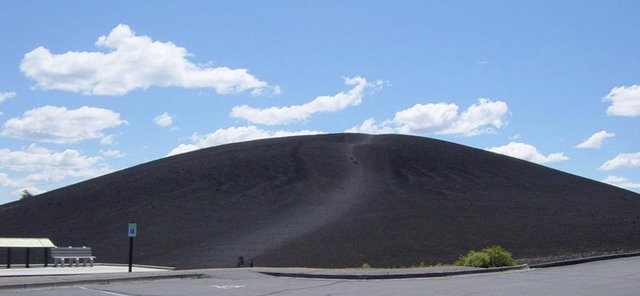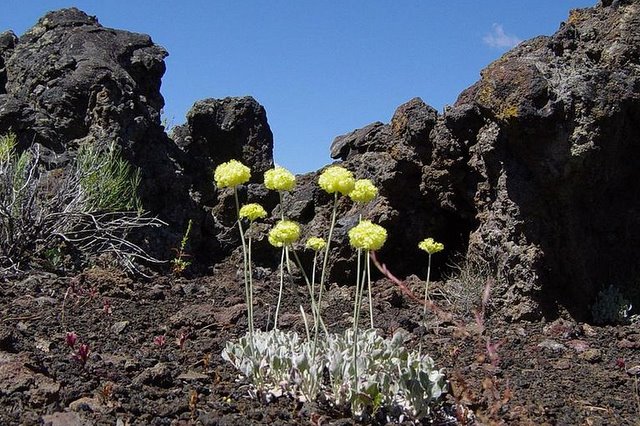|
|
The Dark Side of the MoonNonfictionMike Medberry

"The contrast of black lava against the clear cobalt sky looks stunning but this is a lonely place: alien, rugged, deserted, and dangerous, a land of shattered saucers and teacups of aa lava." T aking a stroll in the Craters of the Moon National Monument in Idaho is like walking on the dark side of the moon. The contrast of black lava against the clear cobalt sky looks stunning but this is a lonely place: alien, rugged, deserted, and dangerous, a land of shattered saucers and teacups of aa lava. Fifty-four miles north to south and 25 miles east to west, this vast monument harbors no flowing rivers or creeks. The lava reaches 140 degrees in the summer and sub-zero temperatures in the winter. Craters of the Moon is a hell of a place to lie stranded and facing death. But I get ahead of myself.
As an environmentalist seeking to expand the Craters of the Moon National Monument, I visited the area with three friends--Miguel Fredes, Katie Fite, Doug Schnitzspahn. We drove four hours from Boise and turned onto a remote road near Arco, a small town in eastern Idaho. There are few trails through the lava. Those who walk here find their boot soles torn up by the sharp rocks. The ridges of lava run like serrated knives across the countryside. We were here to gain information about the effects of livestock grazing, hunting, and off-road vehicle use on the lava formations. We wanted to check the conditions of plants like miniature monkey flowers and dwarf buckwheat as well as animals like mule deer, badger, and red foxes. We wanted to be able to say to critics: “I know that land by foot, not by hearsay or speculation.”

Dwarf buckwheat at Craters of the Moon National Monument. I especially wanted to see Laidlaw Park, a kipuka: an island of soil and grass surrounded by miles of lava from the Great Rift lava flow. At 50,000 acres, the Laidlaw Park kipuka is said to be the largest in the United States, supporting many unusual plants and animals. Parched but fertile, it is open to limited livestock grazing and so is less damaged than most of America’s public lands. We walked for an hour over a solid lava flow where sagebrush grew like whiskers on a roughened face. When I could afford to look up instead of at my feet, I saw an endless reach of black rock and dark stretches of rubble. In April, Craters of the Moon has a Jekyll and Hyde persona--sleety squalls followed by brief warm spells. After another hour, we reached Little Laidlaw Park. There, we stopped and looked south into its big brother, Big Laidlaw Park, an oceanic expanse of blowing grasses. The piebald grasslands of Laidlaw Park kipuka looked like a quilt of roughly spun black and tan wool. We crossed a raised isthmus of lava that offered a sweeping view of the land we proposed to add to the monument. As the four of us stared at the view, my head began to throb. When had this killer headache come on? I asked Katie for an aspirin. No, make it two. Earlier that day at the campground, I had stumbled oddly. Now, the pain was excruciating--aspirin did nothing to abate it. I tried to shake my head into sense. After taking in the view, we headed back towards our cars, enveloped in a strange, blowing mist. I thought about a Moosehead beer, chips with red-hot salsa, and warming my hands by the heater of my car. My friends plodded on with their heads buried in raincoat hoods as we crossed the stormy sea of black rock. There were no trails out here, and when we separated, I figured we’d meet at the cars in Laidlaw Park.

"Fifty-four miles north to south and 25 miles east to west, this vast monument harbors no flowing rivers or creeks."
I hopped through the lava until my head felt better. But then I stumbled on nothing. When I awoke, my legs were useless, my thoughts incoherent. I had hit my head hard and I was in pain, not from the outside, but somewhere inside I couldn’t quite touch. I tried to yell, “Hey, guys, wait up!” but I couldn’t sit up.
I looked to see who or what had taken me down. Was it a heart attack, a gunshot? I was 44 years old and in good condition. I’d run a half-marathon the day before, finishing 88th out of 2,200 people. Yet I lay immobilized on this lava. Inert on the lava, I tried to take an inventory. I looked at the world with my one good eye. Why was the world so bleary in the other? It was wet and hurting like the monstrous eye of a Cyclops. How long had I laid there? Minutes, seconds, hours? My right leg wouldn’t work and my right arm was as limp as a shot rabbit. But my left arm and leg had life in them. Surely, I could stand and walk. I pushed up on my left arm but then fell. My face felt like it had been hacked in two, blood running down one side. I’d get out of this, I told myself. That’s what I’d always done before. But now something was wrong with my brain. My mind spun as if caught in a hurricane. What the hell was happening? My mind moved randomly to the past. I remembered my 54-year-old father, Ray, had a stroke. I was twelve and couldn’t understand it then, but he must have experienced this same feeling. My father, a lawyer, had been rendered speechless. In the hospital he wore a pirate’s eye-patch and a white turban to hide the cut the doctors had opened in his head. My father pointed, shook his finger, and grunted as he looked out the window of Tripler Hospital in Hawaii. He died six months later. Now I knew the torture of his death firsthand. I wanted out of this goddamned black rock desert, but the lava proved an impossible obstacle. I slid down a slanted section and caught a branch. Everything blurred. I held onto the branch with all my strength—if I let go I feared sliding upside-down into heavier brush where I would be lost from sight. I passed out and woke to see the sun shining brightly and the clouds sending out spokes of light. It was a godlike moment. Then the clouds darkened and threatened rain. The day grew shorter. The sun would soon go down and I would shiver to death on a mild April night. I called out to the earth, but what use was that? The earth I’d worked 20 years to protect was silent. I closed my eyes, breathed heavily, and cried for mercy. My life as I had known it had vanished. My hopes for saving this land would be lost if I couldn’t get the hell going. I saw the sun in bright, psychedelic colors of orange, red, and yellow. I hung onto the branch even though I couldn’t see it. I wanted to move but couldn’t do it. It felt like there was a large animal standing on top of my chest, pinning me to the ground. I closed my eyes and tried to make this horrible mirage disappear, but my mind whispered that it had come to me for a reason.
Lava waves at Craters of the Moon. Photo by Mike Medberry. I drifted in and out of consciousness, in and out of pain, in and out of reality. What was real? The smell of sagebrush, the wetness of rain, the hardness of rock underneath, the sun on my face?
My friends would get back to the cars and be annoyed, thinking I had gotten lost. They’d wait for an hour, worry and come back to look for me. But where would they look? And if they found me, what then? I was in trouble beyond what I could fathom. I couldn’t put my feet under me—I couldn’t even see them. When I tried to holler I could only mumble. I couldn’t understand my garbled words. I was reduced to the gurgling sounds of a baby. I became a pure observer. I breathed deeply and knew this day would be my last. I’d be still and dead by morning. I felt myself a part of this burned-out landscape, no more than the lava and no less. I gave myself to it--its warmth, brightness, burning rays, and cold stillness. I felt entirely at peace. Dying would not be so bad.I don’t know how long I lay there, but I saw a vision of my friends coming out of the mist. In a flash I wanted to live. I called to Doug. He heard and turned toward me. Thank God! I was saved! Doug came over to me and then stopped short. He called for Katie and Miguel. Most of the blood all over my face had dried and one side drooped like the jowls of a basset hound. My body hung like an awkward question mark, my good arm hugging the branch with all my strength. Doug thought I had broken my neck. The three of them moved me carefully to a level, grassy place. Then Katie went for help.
Lava Pillars at Craters of the Moon. Photo by Mike Medberry.
I desperately wanted water. Doug looked at me and fell silent, believing water was the wrong thing to give me. He walked away to smoke a cigarette and collect his thoughts. Miguel gave me a cup of yogurt, which I opened and spilled all over myself.
After three hours, a helicopter landed like a big dragonfly in a nearby grassy area. Several men moved slowly across the lava, their flashlights shining like fireflies. One man put a scarf over my face as if I were dead. Then they put me onto a stretcher and carried me to the helicopter. They were like ghosts gliding across the kipuka. I rose in the helicopter and flew to a hospital 45 miles south in Pocatello. It had been six hours since I had fallen. In attempting to protect Idaho’s wild landscape I had ruined myself. Now I would have to rehabilitate my body as well as this land I loved. Everything that mattered to me--thinking, writing, working to protect the Craters of the Moon—had vanished. I couldn’t know the magnitude of the struggle ahead nor the energy it would take to bring myself back from the stroke. Unraveling this terrible confusion--relearning to walk, speak, write, and love--would take geologic time.
MIKE MEDBERRY, MFA, is a writer based in McCall, Idaho. "The Dark Side of the Moon" is the opening chapter of his memoir about surviving a stroke at Craters of the Moon and relearning to walk, talk, speak and work to protect this beloved landscape, even though it had nearly killed him.
|
